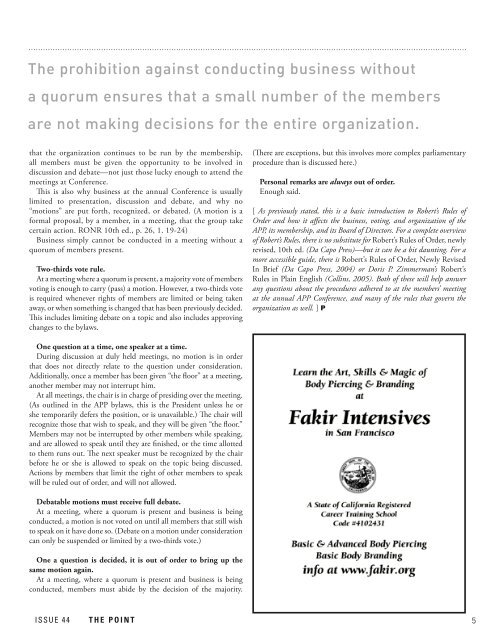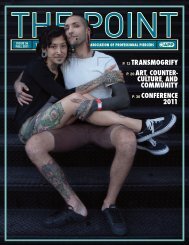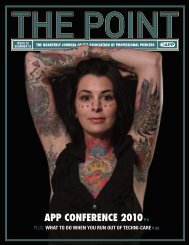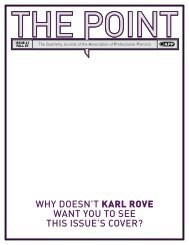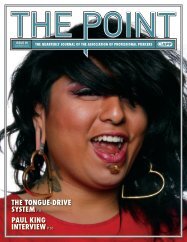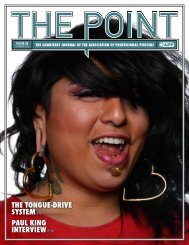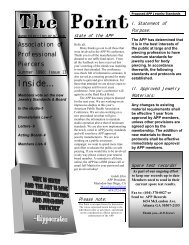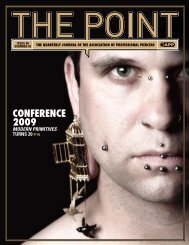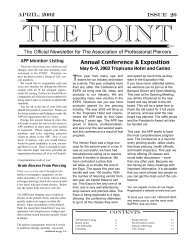The Piercing & tattooing among the aleut the - Association of ...
The Piercing & tattooing among the aleut the - Association of ...
The Piercing & tattooing among the aleut the - Association of ...
Create successful ePaper yourself
Turn your PDF publications into a flip-book with our unique Google optimized e-Paper software.
<strong>The</strong> prohibition against conducting business without<br />
a quorum ensures that a small number <strong>of</strong> <strong>the</strong> members<br />
are not making decisions for <strong>the</strong> entire organization.<br />
that <strong>the</strong> organization continues to be run by <strong>the</strong> membership,<br />
all members must be given <strong>the</strong> opportunity to be involved in<br />
discussion and debate—not just those lucky enough to attend <strong>the</strong><br />
meetings at Conference.<br />
This is also why business at <strong>the</strong> annual Conference is usually<br />
limited to presentation, discussion and debate, and why no<br />
“motions” are put forth, recognized, or debated. (A motion is a<br />
formal proposal, by a member, in a meeting, that <strong>the</strong> group take<br />
certain action. RONR 10th ed., p. 26, 1. 19-24)<br />
Business simply cannot be conducted in a meeting without a<br />
quorum <strong>of</strong> members present.<br />
Two-thirds vote rule.<br />
At a meeting where a quorum is present, a majority vote <strong>of</strong> members<br />
voting is enough to carry (pass) a motion. However, a two-thirds vote<br />
is required whenever rights <strong>of</strong> members are limited or being taken<br />
away, or when something is changed that has been previously decided.<br />
This includes limiting debate on a topic and also includes approving<br />
changes to <strong>the</strong> bylaws.<br />
(<strong>The</strong>re are exceptions, but this involves more complex parliamentary<br />
procedure than is discussed here.)<br />
Personal remarks are always out <strong>of</strong> order.<br />
Enough said.<br />
[ As previously stated, this is a basic introduction to Robert’s Rules <strong>of</strong><br />
Order and how it affects <strong>the</strong> business, voting, and organization <strong>of</strong> <strong>the</strong><br />
APP, its membership, and its Board <strong>of</strong> Directors. For a complete overview<br />
<strong>of</strong> Robert’s Rules, <strong>the</strong>re is no substitute for Robert’s Rules <strong>of</strong> Order, newly<br />
revised, 10th ed. (Da Capo Press)—but it can be a bit daunting. For a<br />
more accessible guide, <strong>the</strong>re is Robert’s Rules <strong>of</strong> Order, Newly Revised<br />
In Brief (Da Capo Press, 2004) or Doris P. Zimmerman’s Robert’s<br />
Rules in Plain English (Collins, 2005). Both <strong>of</strong> <strong>the</strong>se will help answer<br />
any questions about <strong>the</strong> procedures adhered to at <strong>the</strong> members’ meeting<br />
at <strong>the</strong> annual APP Conference, and many <strong>of</strong> <strong>the</strong> rules that govern <strong>the</strong><br />
organization as well. ] P<br />
One question at a time, one speaker at a time.<br />
During discussion at duly held meetings, no motion is in order<br />
that does not directly relate to <strong>the</strong> question under consideration.<br />
Additionally, once a member has been given “<strong>the</strong> floor” at a meeting,<br />
ano<strong>the</strong>r member may not interrupt him.<br />
At all meetings, <strong>the</strong> chair is in charge <strong>of</strong> presiding over <strong>the</strong> meeting.<br />
(As outlined in <strong>the</strong> APP bylaws, this is <strong>the</strong> President unless he or<br />
she temporarily defers <strong>the</strong> position, or is unavailable.) <strong>The</strong> chair will<br />
recognize those that wish to speak, and <strong>the</strong>y will be given “<strong>the</strong> floor.”<br />
Members may not be interrupted by o<strong>the</strong>r members while speaking,<br />
and are allowed to speak until <strong>the</strong>y are finished, or <strong>the</strong> time allotted<br />
to <strong>the</strong>m runs out. <strong>The</strong> next speaker must be recognized by <strong>the</strong> chair<br />
before he or she is allowed to speak on <strong>the</strong> topic being discussed.<br />
Actions by members that limit <strong>the</strong> right <strong>of</strong> o<strong>the</strong>r members to speak<br />
will be ruled out <strong>of</strong> order, and will not allowed.<br />
Debatable motions must receive full debate.<br />
At a meeting, where a quorum is present and business is being<br />
conducted, a motion is not voted on until all members that still wish<br />
to speak on it have done so. (Debate on a motion under consideration<br />
can only be suspended or limited by a two-thirds vote.)<br />
One a question is decided, it is out <strong>of</strong> order to bring up <strong>the</strong><br />
same motion again.<br />
At a meeting, where a quorum is present and business is being<br />
conducted, members must abide by <strong>the</strong> decision <strong>of</strong> <strong>the</strong> majority.<br />
ISSUE 44 T H E P O I N T 5


